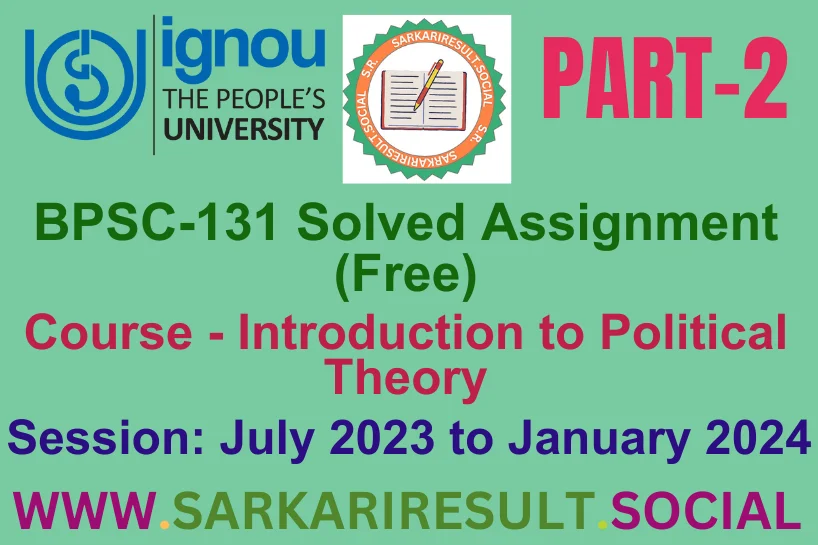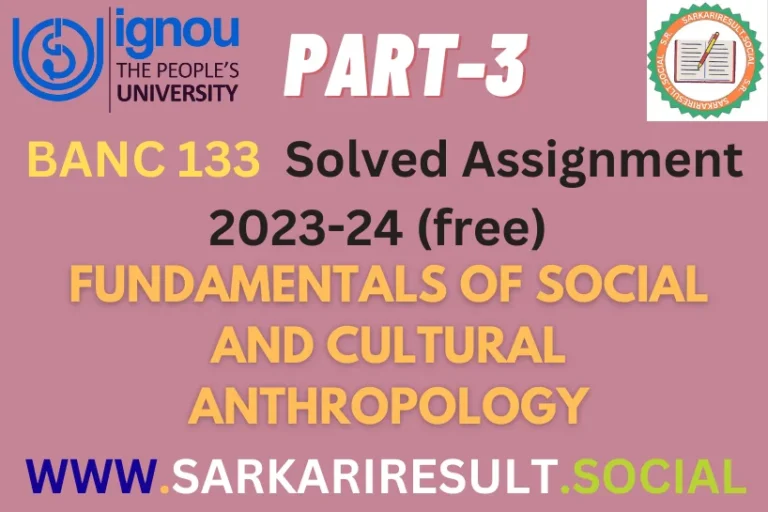BPSC 131 SOLVED IGNOU ASSIGNMENT FREE PART 2

Welcome to the BPSC 131 SOLVED IGNOU ASSIGNMENT FREE PART 2 TMA. Assignment – II streamlines your approach with concise answers to three pivotal questions. In about 250 words each, explain J.S. Mill’s notion of ‘Liberty’, discuss equality of opportunity, and elaborate upon justice as a term of synthesis. Our short and focused responses provide a straightforward path for grasping these critical aspects of political theory, ensuring a smooth and successful completion of your assignments.

Answer the following questions in about 250 words each.
Q.3 What is J.S. Mill’s notion of Liberty’? Explain.
Ans. John Stuart Mill’s notion of liberty is articulated in his seminal work “On Liberty,” where he passionately advocates for individual freedom and the limitations of state interference. Mill’s concept of liberty is multifaceted and can be understood through the following key points:
1. Principle of Harm:
– Mill’s philosophy is grounded in the harm principle, asserting that the only justification for limiting an individual’s liberty is to prevent harm to others. This principle places a fundamental restriction on state intervention and emphasizes individual autonomy.
2. Self-Development:
– Mill argues that liberty is essential for individual self-development and the pursuit of happiness. He contends that individuals are the best judges of their own well-being and that freedom allows for diverse and autonomous paths of self-discovery and fulfillment.
3. Public and Private Spheres:
– Mill distinguishes between the public and private spheres. While acknowledging the need for societal regulations in the public realm to prevent harm, he staunchly defends the sanctity of the private sphere, arguing against interference in personal choices, beliefs, and lifestyles.
4. Freedom of Thought and Expression:
– Mill champions the freedom of thought and expression as vital components of liberty. He contends that even unpopular opinions must be allowed to be expressed since the clash of ideas is essential for societal progress and the discovery of truth.
5. Tyranny of the Majority:
– Mill is concerned about the “tyranny of the majority,” where the majority, through legal means, imposes its will on dissenting individuals. He underscores the importance of protecting minority rights and dissenting voices to prevent conformity at the expense of individual liberty.
6. Individuality:
– Mill celebrates individuality and diversity, arguing that a society that fosters different ways of life and diverse opinions is richer and more vibrant. He warns against societal pressures that lead to a stifling conformity and advocates for embracing individual eccentricities.
7. Limits on State Power:
– Mill proposes strict limits on state power, emphasizing that governments should only intervene to prevent harm to others. He critiques paternalistic interventions, arguing that individuals should have the freedom to make their own mistakes as long as they don’t harm others.
In summary, J.S. Mill’s notion of liberty is deeply rooted in the idea of individual autonomy, the pursuit of happiness, and the minimal interference of the state. His philosophy has significantly influenced discussions on the balance between individual freedoms and societal interests.
Q.4 Discuss equality of opportunity.
Ans. Equality of opportunity is a foundational principle in political philosophy that advocates for fairness in the distribution of opportunities, ensuring that everyone has an equal chance to succeed and achieve their goals. This concept is integral to the broader discussions on social justice and has implications for various aspects of public policy. Here are key points to consider in understanding equality of opportunity:
1. Basic Definition:
– Equality of opportunity refers to a state where individuals, regardless of their background or circumstances of birth, have an equal chance to access education, employment, and other social goods.
2. Meritocracy:
– The ideal of equality of opportunity often aligns with the concept of meritocracy, where individuals advance based on their talents, efforts, and achievements rather than factors such as wealth, race, gender, or social class.
3. Education:
– A crucial component of equality of opportunity is equal access to education. Policies that address disparities in educational resources, quality, and affordability contribute to leveling the playing field.
4. Employment:
– In the realm of employment, equality of opportunity implies that hiring and promotion decisions should be based on qualifications, skills, and performance rather than discriminatory factors like gender, ethnicity, or socioeconomic background.
5. Social Mobility:
– The concept is closely linked to the idea of social mobility, where individuals can move up or down the social and economic ladder based on their abilities and efforts, rather than being constrained by their birth circumstances.
6. Anti-Discrimination Policies:
– To promote equality of opportunity, societies often implement anti-discrimination laws and policies that prohibit unfair treatment based on characteristics such as race, gender, sexual orientation, or disability.
7. Challenges and Critiques:
– Achieving true equality of opportunity faces challenges. Socioeconomic disparities, institutional biases, and historical inequalities can create barriers that hinder equal access to opportunities. Critics argue that addressing structural issues is essential to realizing genuine equality of opportunity.
8. Affirmative Action:
– Some societies implement affirmative action policies to actively counter historical discrimination. These policies aim to create opportunities for underrepresented groups, promoting a more inclusive and diverse environment.
9. Global Perspective:
– Equality of opportunity is not only a concern within individual nations but also on a global scale. Discussions about fair trade, international aid, and global economic policies often involve considerations of providing equal opportunities to people worldwide.
In conclusion, equality of opportunity is a principle that seeks to ensure fairness and justice by removing obstacles that prevent individuals from realizing their full potential. It is an ongoing aspiration that requires continual efforts to address systemic inequalities and create a more just and inclusive society.
Q.5 Elaborate upon justice as a term of synthesis.
Ans. Justice, as a term of synthesis, involves the harmonious integration of various ethical principles, social values, and legal frameworks to achieve a fair and equitable societal order. This concept recognizes the complexities of human interactions, the diversity of perspectives, and the need for a balanced synthesis that respects individual rights while fostering collective well-being. Here are key aspects of justice as a term of synthesis:
1. Balancing Individual Rights and Common Good:
– Justice as synthesis seeks to strike a balance between safeguarding individual rights and promoting the common good. It acknowledges that a just society must protect the liberties of individuals while also ensuring the welfare and interests of the community.
2. Ethical Pluralism:
– In a diverse and pluralistic society, justice as synthesis acknowledges the existence of multiple ethical frameworks and cultural values. It seeks to synthesize these diverse perspectives to form a cohesive and inclusive understanding of justice that respects various worldviews.
3. Legal and Moral Dimensions:
– Justice encompasses both legal and moral dimensions. Legal justice involves the application of laws and regulations, while moral justice considers ethical principles and shared values. The synthesis involves aligning legal frameworks with ethical standards.
4. Restorative Justice:
– The term of synthesis is evident in restorative justice, which emphasizes repairing harm caused by wrongdoing and reconciling the interests of victims, offenders, and the community. It seeks a synthesis between accountability and rehabilitation.
5. Social Justice:
– Justice as a term of synthesis is central to the concept of social justice. It addresses systemic inequalities by synthesizing principles of fairness, inclusivity, and distributive justice to create a society where opportunities and resources are equitably shared.
6. Responsive to Change:
– A just system is adaptable and responsive to changing social dynamics. It involves a continual synthesis of legal and ethical norms to ensure that justice evolves with societal progress and addresses emerging challenges.
7. Procedural and Substantive Justice:
– Justice as synthesis considers both procedural fairness (fair processes and legal procedures) and substantive justice (fair outcomes and distribution of resources). The synthesis ensures that the means and ends align to create a just system.
8. Global Justice:
– In an interconnected world, justice as a term of synthesis extends beyond national boundaries. It involves synthesizing principles of global ethics, human rights, and international law to address issues such as poverty, climate change, and geopolitical conflicts.
In essence, justice as a term of synthesis embodies the dynamic process of integrating diverse ethical, legal, and social elements to construct a balanced and equitable societal framework. It reflects a commitment to fostering a harmonious coexistence where individual rights, collective well-being, and ethical principles are synthesized for the greater good.
Also See This: BPSC 131 SOLVED IGNOU ASSIGNMENT FREE PART 3







